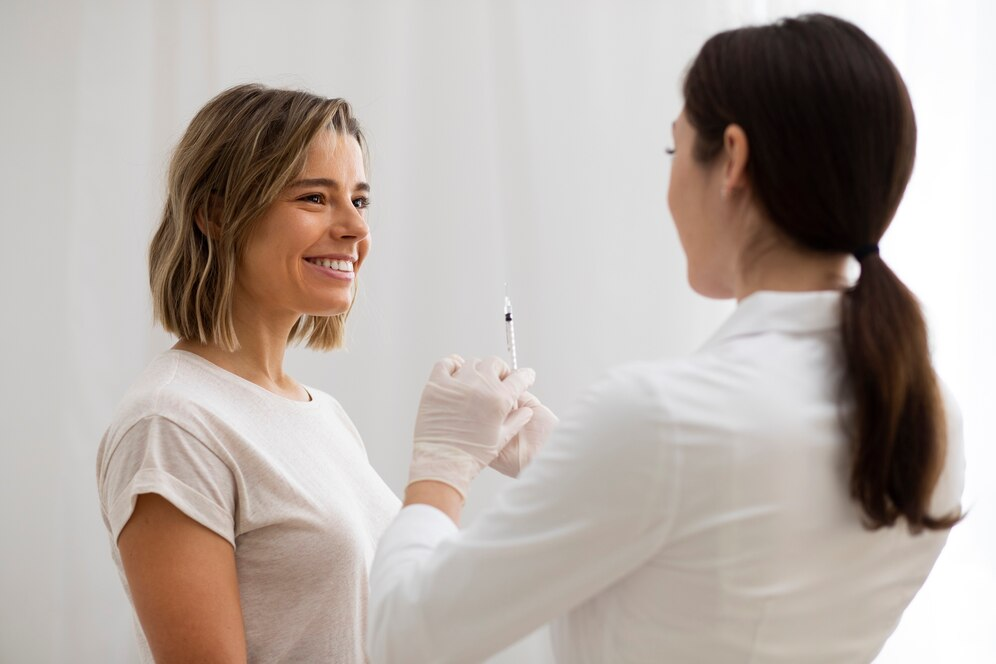If you’re exploring hormone replacement options, you’ve probably encountered numerous testosterone therapy myths for women that make it difficult to separate fact from fiction. Many women avoid this potentially beneficial treatment because of misconceptions about severe side effects. However, the data tells a different story. Studies show that up to 46% of women experience low testosterone levels during perimenopause and menopause, yet fewer than 5% receive appropriate treatment. This gap primarily exists due to persistent misinformation.
The most common testosterone therapy myths for women include fears of developing masculine features, concerns about cancer risk, and beliefs that women don’t need testosterone at all. Understanding what the research actually shows can help you make an informed decision about whether testosterone therapy is right for you. Let’s examine the evidence and clear up the confusion.

Key Takeaways
- Testosterone is essential for women’s libido, energy, mood, muscle mass, and cognitive function, naturally declining after age 30.
- Masculinization from testosterone therapy is rare with proper dosing; appropriate treatment actually supports cardiovascular health, not harm.
- Ideal candidates experience low libido, fatigue, muscle loss, or mood changes with below-optimal testosterone levels confirmed by testing.
- Benefits include enhanced sexual satisfaction, increased energy, improved muscle mass, sharper mental clarity, and better bone density.
- Safe treatment requires qualified practitioners with BHRT expertise, individualized dosing, and regular monitoring every 6-8 weeks initially.
4 Testosterone Therapy Myths For Women
| Myth | Fact |
|---|---|
| Testosterone therapy causes masculinization in women | Properly prescribed testosterone therapy rarely causes virilization. Dosage is carefully personalized. |
| It’s only for men or transgender patients | Women produce and need testosterone naturally; therapy helps restore deficient levels. |
| Testosterone therapy always leads to acne and hair loss | Side effects are dose-dependent and uncommon when therapy is monitored. |
| Testosterone therapy is unsafe and unproven. | Research and clinical experience support the benefits and safety of BHRT under medical supervision. |
| Low libido in women is solely psychological. | Hormonal imbalances, including low testosterone, play a significant role in female sexual dysfunction. |
| Testosterone therapy is a quick fix with no other benefits | Therapy supports energy, mental clarity, muscle strength, mood balance, and bone health. |
The Role of Testosterone in Women’s Bodies
Testosterone is an essential hormone in women’s health. Your body makes it in three places: your ovaries produce about 25%, your adrenal glands make another 25%, and other tissues in your body create the remaining 50%. This hormone supports your sex drive, energy levels, mood, muscle strength, bone health, and mental clarity.
Your testosterone levels naturally change throughout your menstrual cycle and peak when you ovulate. Research from the Journal of Clinical Endocrinology & Metabolism shows that women’s testosterone drops by about 50% between the ages 20 and 45. The decline speeds up during perimenopause and menopause. This is when hormone balancing for women becomes especially important.
A study in the Menopause Journal found that women with the lowest testosterone levels experienced more sexual problems and fatigue than women with normal levels. Low testosterone can cause low sex drive, constant tiredness, muscle weakness, weight gain, and mood changes. These symptoms can really impact your daily life. Understanding testosterone therapy myths for women helps you know when treatment might help instead of accepting these changes as just a regular part of getting older.
Who May Be a Candidate for Testosterone Treatment
 You may benefit from testosterone therapy if you’re experiencing persistent low libido, constant fatigue, loss of muscle mass, or mood changes during perimenopause or menopause, especially when other treatments haven’t helped. The best candidates have testosterone levels below the optimal range, along with these symptoms.
You may benefit from testosterone therapy if you’re experiencing persistent low libido, constant fatigue, loss of muscle mass, or mood changes during perimenopause or menopause, especially when other treatments haven’t helped. The best candidates have testosterone levels below the optimal range, along with these symptoms.
Before starting treatment, you’ll need a comprehensive evaluation that includes a review of your symptoms, medical history, and hormone testing. Testosterone therapy is not appropriate if you have active breast cancer, are pregnant, or have severe heart disease.
Natural hormone balancing is most effective when you’re committed to regular monitoring and willing to make lifestyle changes that support your treatment. Women who want to address the root cause of their symptoms rather than just mask them typically see the best results with this approach. Understanding testosterone therapy myths for women helps ensure you have realistic expectations about what treatment can and cannot do for your health.
7 Potential Benefits of Testosterone Therapy For Women
When properly administered and monitored, testosterone therapy can offer significant improvements in multiple areas of health. Many of the perceived risks associated with this treatment stem from testosterone therapy myths for women rather than clinical evidence. Here are seven potential benefits supported by research:
- Improved Sexual Function and Libido – Testosterone directly supports sexual desire, arousal, and satisfaction. Studies show that women with low testosterone who receive appropriate replacement therapy report meaningful improvements in their sex lives.
- Increased Energy and Reduced Fatigue – Many women experience a noticeable boost in daily energy levels and reduction in persistent tiredness that hasn’t responded to other interventions.
- Enhanced Muscle Mass and Strength – Testosterone supports the development and maintenance of lean muscle tissue, making it easier to build strength and maintain physical function as you age.
- Better Bone Density – This hormone plays a protective role in bone health, helping to reduce the risk of osteoporosis and fractures, particularly important during and after menopause.
- Improved Mood and Mental Clarity – Testosterone supports neurotransmitter function, which can lead to better mood regulation, decreased anxiety, and sharper cognitive function, including memory and focus.
- Healthier Body Composition – Adequate testosterone levels help your body maintain a favorable ratio of muscle to fat, making it easier to manage weight and metabolic health.
- Increased Motivation and Sense of Wellbeing – Many women report feeling more like themselves again, with improved drive, confidence, and overall quality of life.
Don’t let testosterone therapy myths for women prevent you from exploring whether this treatment could address your specific health concerns.
Realistic Side Effects and Safety Considerations
Although testosterone therapy offers significant benefits, understanding potential side effects guarantees informed decision-making and ideal treatment outcomes. When monitored adequately by qualified practitioners, adverse reactions remain minimal and manageable.
| Common Side Effects | Management Strategies |
|---|---|
| Mild acne or skin changes | Topical treatments, dose adjustments |
| Hair thinning/growth changes | Regular monitoring, dosage modification |
| Voice deepening (rare) | Immediate dose reduction, discontinuation |
| Mood fluctuations | Psychological support, lifestyle modifications |
| Sleep disturbances | Sleep hygiene protocols, timing adjustments |
Methods of Testosterone Administration for Women
Multiple delivery methods enable precise testosterone dosing while accommodating individual preferences and physiological responses. Each administration route offers distinct pharmacokinetic profiles and clinical advantages that your practitioner will evaluate based on your hormonal assessment and treatment goals.
Available testosterone delivery systems include:
- Topical gels and creams – Applied daily to skin for steady absorption and flexible dosing adjustments
- Sublingual troches – Dissolve under tongue for rapid absorption, bypassing hepatic metabolism
- Pellet implants – Subcutaneous insertion providing 3-6 months of consistent hormone release
- Injection therapy – Intramuscular administration offering precise dosing control and monitoring
- Vaginal suppositories – Localized delivery targeting genitourinary symptoms with minimal systemic exposure
Your clinician will determine the best delivery method based on your metabolic profile, lifestyle factors, and therapeutic objectives, while ensuring that appropriate monitoring protocols are in place.
Monitoring and Adjusting Treatment Plans
Successful testosterone therapy requires personalized dosing and careful monitoring. Before starting treatment, you’ll undergo baseline hormone testing to measure your total and free testosterone, SHBG, and other key markers. Follow-up testing occurs every 6 to 8 weeks initially, then every three months once your levels stabilize.
Your practitioner will review both your lab results and symptoms to adjust your dosage as needed. You’ll be monitored for potential side effects, including acne, unwanted hair growth, voice changes, and changes in cholesterol levels. Many testosterone therapy myths for women suggest that side effects are inevitable, but proper monitoring helps catch and address issues early. Your treatment plan stays flexible because your hormone needs can change due to stress, weight fluctuations, or other medications.
Bioidentical Hormone Replacement Therapy works best with this individualized approach. Regular adjustments ensure you get the therapeutic benefits you need while staying safe throughout your treatment. This ongoing partnership between you and your provider helps dispel testosterone therapy myths for women by demonstrating how personalized care delivers real results without unnecessary risks.
Finding the Right Healthcare Provider for Hormone Therapy
When selecting a healthcare provider for testosterone therapy, you’ll need to prioritize practitioners who possess specialized training in bioidentical hormone replacement therapy and demonstrate a thorough understanding of female endocrinology. Finding the right clinician ensures safe and effective treatment tailored to your unique hormonal profile.
Key qualifications to seek include:
- Board certification in functional medicine, naturopathic medicine, or endocrinology
- Extensive experience with BHRT protocols and thorough hormone testing
- Commitment to individualized dosing strategies rather than one-size-fits-all approaches
- Integration of lifestyle counseling, nutritional support, and stress management
- Regular monitoring protocols with detailed follow-up assessments
You deserve a provider who listens to your concerns, explains treatment rationale clearly, and collaborates with you throughout your hormone optimization process. The right practitioner will combine clinical expertise with personalized care.

Conclusion: Moving Beyond Testosterone Therapy Myths for Women
You deserve accurate information when making decisions about your health. Testosterone is essential for women’s wellbeing at every age, and you don’t have to accept declining levels as just part of getting older. While testosterone therapy myths for women have created unnecessary worry, research shows that proper treatment is safe and can significantly improve your quality of life when you have a real deficiency.
Every woman is different. What helps one person might not be right for you. That’s why getting tested and working with a knowledgeable provider is so important. If you’re dealing with low energy, decreased sex drive, or other symptoms of low testosterone, finding out your levels is the first step. You deserve to feel like yourself again.
At Soleil Acupuncture & Naturopathic Wellness, we help women understand their hormone health through testing, personalized treatment, and caring support. Our team combines natural medicine with proven therapies to help you feel your best. Don’t let testosterone therapy myths for women keep you from exploring options that could help. Contact us today to schedule a consultation and start your journey toward better health.

